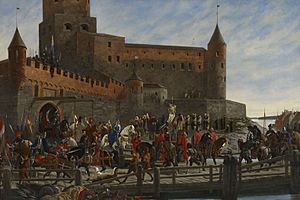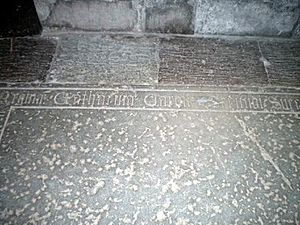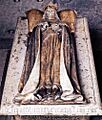Charles VIII of Sweden facts for kids
Quick facts for kids Charles VIII |
|||||
|---|---|---|---|---|---|

Wood sculpture of Charles by his contemporary Bernt Notke. Made posthumously (c. 1480s), but considered to have real likeness.
|
|||||
| King of Sweden | |||||
| Reign | 20 June 1448 – 24 February 1457 9 August 1464 – 30 January 1465 12 November 1467 – 15 May 1470 |
||||
| Coronation | 29 June 1448, Uppsala | ||||
| Predecessor | Christopher | ||||
| Successor | John (1497) | ||||
| King of Norway | |||||
| Reign | 20 November 1449 – June 1450 | ||||
| Coronation | 20 November 1449, Trondheim | ||||
| Predecessor | Christopher | ||||
| Successor | Christian I | ||||
| Born | c. 1408 Ekholmen Castle, Veckholm, Uppsala |
||||
| Died | 15 May 1470 (aged 60) Stockholm Castle |
||||
| Burial | Riddarholm Church, Stockholm | ||||
| Spouse | Birgitta Turesdotter (Bielke) Catherine Kristina Abrahamsdotter |
||||
| Issue among others... |
Magdalen Karlsdotter | ||||
|
|||||
| House | Bonde | ||||
| Father | Knut Tordsson Bonde | ||||
| Mother | Margareta Karlsdotter | ||||
| Religion | Roman Catholicism | ||||
Charles VIII (born Karl Knutsson, around 1408–1470) was a very important figure in Swedish history. He was king of Sweden three times (1448–1457, 1464–1465, and 1467–1470). He was also king of Norway for a short time (1449–1450).
Charles was born into a powerful noble family. He held several important jobs, like being a top military leader in Sweden. After King Christopher of Bavaria died in 1448, Charles was chosen as king of Sweden. He also tried to become king of Norway. His time as king was full of wars and rebellions. He was removed from the throne twice but managed to become king again each time.
Charles worked hard to break up the Kalmar Union. This was a union of Denmark, Norway, and Sweden. He wanted Sweden to be an independent country. Charles had several children from his marriages and another relationship. His only son who lived, Charles Karlsson, did not become king. However, Charles VIII's family line later became kings and queens in many European countries. This includes Norway, Greece, Great Britain, Belgium, and Spain. Today, the current King of Sweden, Carl XVI Gustav, is a distant relative of Charles VIII. This means Charles's family line is back on the Swedish throne.
Contents
Who was Charles VIII?
Charles was actually the second Swedish king named Charles (Karl). The name Charles VIII was given to him much later. This happened when Charles IX of Sweden (who ruled from 1604–1611) decided to count kings named Charles. He used a made-up history of Sweden to get his number. Six kings before Charles VII of Sweden were not known in any records before a book written in the 1500s. Charles was the first Swedish king named Charles to use a number during his own time. He was known as Charles II on his wife's tombstone in 1451.
Early Life and Family
Karl Knutsson was born in October 1408 or 1409. His birthplace was Ekholmen Castle. His father, Knut Tordsson, was a knight and a member of the Swedish Privy Council (a group of important advisors). His mother, Margareta Karlsdotter, came from a very old and important family.
Charles married three times. His first wife was Birgitta Turesdotter (Bielke). They married in 1428 and had a daughter named Christina. After Birgitta died, he married Catherine in 1438. They had a daughter named Magdalena of Sweden. He also had two children, Anna and Karl, with Christina Abrahamsdotter.
Becoming a Powerful Leader
In 1434, Charles became a member of the Privy Council of Sweden. This was a group of powerful nobles who advised the king. In October of that year, he became the Lord High Constable of Sweden. This was a very high military position.
People were not happy with King Eric of Pomerania. So, in 1436, Charles was made Rikshövitsman. This meant he was the military governor of the whole country. From 1438 to 1440, he even became the elected ruler of Sweden. This happened after a rebellion led by Engelbrekt Engelbrektsson. During this time, a peasant rebellion also happened in Finland.
King Eric of Pomerania was forced to step down. In 1440, Christopher of Bavaria was chosen as the new king of Sweden, Norway, and Denmark. When Christopher was crowned in 1441, Charles became a knight. He was also made the Lord High Justiciar of Sweden, which was like being the chief judge. Later, he went back to being the Lord High Constable. From 1442, he was the military governor of Vyborg in Finland.
Charles gained control of many important lands, especially in western Finland. His first main base was in Turku. But King Christopher's government started taking back lands and positions. So Charles had to give up the castle of Turku. Charles then moved to the castle of Vyborg. This castle was on Finland's eastern border. From there, he acted like an independent ruler. He made his own deals with groups like the Hanseatic League and the city of Novgorod.
King of Sweden and Norway

When King Christopher died in 1448 without children, Charles was chosen as king of Sweden. This happened on June 20. On June 28, he was officially recognized as king at the Stones of Mora. This was near Uppsala. Charles had his own soldiers there, which helped him become king.
Meanwhile, Denmark chose Christian I as their new king in September 1448. Charles and Christian then competed for the throne of Norway. Norway had also been ruled by King Christopher. Both kings had supporters in Norway. In 1449, some of Norway's council chose Charles as their king. He was crowned in Nidaros Cathedral in Trondheim on November 20. However, Christian still wanted to be king of Norway. The Swedish nobles did not want to support Charles in a war against Denmark over Norway. So, in June 1450, Charles had to give up the Norwegian throne to Christian.
From 1451, Sweden and Denmark were at war. This war caused a lot of damage. Many nobles in Sweden started to oppose Charles. The Swedish church was a strong opponent. They did not like Charles trying to take more power for himself and the king. Other noble families, like the Oxenstierna and House of Vasa, also opposed him. They had lost power when Charles became king.
Later Reigns
Over the next 20 years, Charles was removed from the throne twice. But he managed to get it back and rule three times in total.
In 1457, a rebellion started. It was led by Archbishop Jöns Bengtsson and a noble named Erik Axelsson Tott. Charles had to go into exile in Danzig (now Gdańsk). The two rebellion leaders became rulers. They then arranged for Christian I of Denmark to be elected king of Sweden.
In 1463, King Christian had a disagreement with the Archbishop about taxes. The Archbishop was put in prison. This led to another rebellion by the Archbishop's family. Christian was forced out of Sweden. Charles was called back by the rebels. He returned with an army of German and Polish soldiers.
When Charles arrived in Sweden, he found himself fighting the Archbishop. After two bloody battles in the winter of 1464–1465, Charles was exiled again. In 1467, Erik Axelsson Tott, who now supported Charles, helped him become king once more. Charles then ruled for three more years. He shared power with the Privy Council. He died in Stockholm in May 1470.
Family
With his wife Birgitta Turesdotter (Bielke), Charles had:
- Ture Karlsson (Bonde) (died young before 1447)
- Christina Karlsdotter (Bonde) (around 1432 – before 1500)
With his wife Catherine, Charles had:
- Margaret Karlsdotter (Bonde) (1442–1462)
- Magdalena of Sweden (1445–1495)
- Richeza Karlsdotter (Bonde) (born around 1445), who became a nun
- Bridget Karlsdotter (Bonde) (1446–1469), who also became a nun
- Four sons who died when they were very young
With his partner Christina Abrahamsdotter, Charles had:
- Anna Karlsdotter (Bonde)
- Charles Karlsson (Bonde) (1465–1488)
Charles had only one son who lived, Charles Karlsson. This son was born to Christina Abrahamsdotter. Charles married Christina just before he died. Even though she was recognized as queen, the Swedish government did not let their son become king. Instead, they chose Charles's nephew, Sten Sture the Elder, to rule as regent.
Legacy
Charles represented a growing feeling among Swedish nobles. They wanted Sweden to be independent and strong. He tried to make Sweden the main power in Scandinavia. Later, he focused on breaking up the Kalmar Union. When the union finally ended, Charles was seen as an early hero for Swedish independence.
Charles was better at fighting for power than at actually being king. He even wrote a short poem about it:
When I was Lord of Fågelvik,
Then I had wealth and might unique.
I was a poor and unhappy man.
But once I was King of the Swedish land,
Charles's great-granddaughter, Christina Nilsdotter Gyllenstierna, married Sten Sture the Younger. Sten Sture also believed in Swedish independence and nationalism.
Even though Charles's direct family line did not immediately become kings, his descendants later became rulers in many countries. This includes Norway, Greece, Great Britain, Belgium, and Spain. In the 20th century, Princess Sibylla of Saxe-Coburg and Gotha married the Swedish prince. Their son, King Carl XVI Gustav of Sweden, brought Charles's family line back to the Swedish throne.
Images for kids
-
Carl's 16th century grave monument in Riddarholm Church
See also
 In Spanish: Carlos VIII de Suecia para niños
In Spanish: Carlos VIII de Suecia para niños




